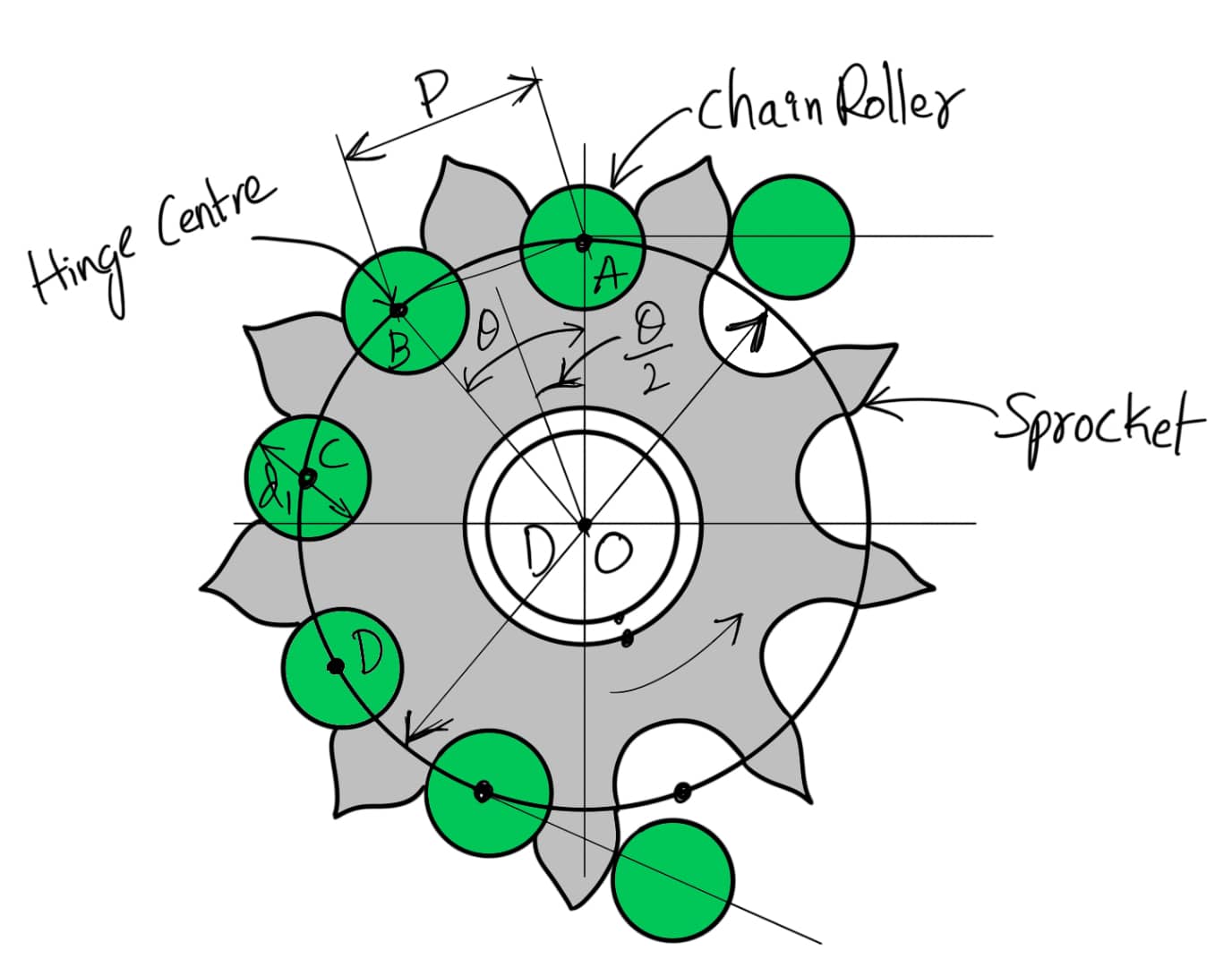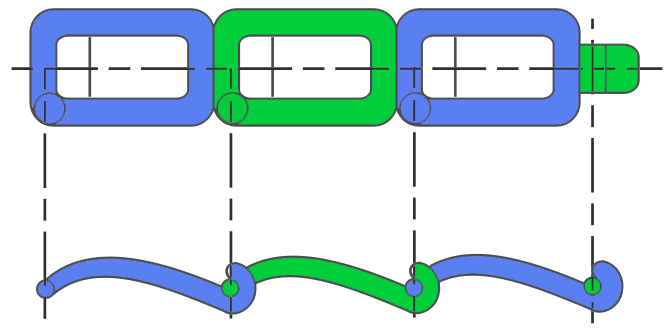We have discussed belt drives and rope drives that slipping may occur. To avoid slipping, steel chains are used. The chains are made up of a number of rigid links which are hinged together by pin joints to provide the necessary flexibility for wrapping around the driving and driven wheels. These wheels have projecting teeth of special profile and fit into the corresponding recesses in the links of the chain. The toothed wheels are known as sprocket wheels or simply sprockets (These wheels resemble spur gears). The sprockets and the chain are thus constrained to move together without slipping, ensuring a perfect velocity ratio. Let us discuss more details about the Chain Drive.

Chain Drive: Chains and Sprockets
The chains are mostly used to transmit motion and power from one shaft to another when the center distance between their shafts is short such as in bicycles, motorcycles, agricultural machinery, conveyors, rolling mills, road rollers, etc. The chains may also be used for long center distances of up to 8 meters. The chains are used for velocities up to 25m/s and power up to 110 kW. In some cases, higher power transmission is also possible.
Following is a schematic Representation of a Chain Drive that comprises Sprockets and a chain.

Chain Drive Advantages over Belt or Rope Drive
- As no slip takes place during the chain drive, hence perfect velocity ratio is obtained.
- Since the chains are made of metal, therefore they occupy less space in width than a belt or rope drive.
- It may be used for both long as well as short distances.
- It gives a high transmission efficiency (up to 98 percent).
- It gives less load on the shafts.
- It can transmit motion to several shafts by one chain only.
- It transmits more power than belts.
- It permits a high-speed ratio of 8 to 10 in one step.
- It can be operated under adverse temperature and atmospheric conditions.
Disadvantages
- The production cost of chains is relatively high.
- The chain drive needs accurate mounting and careful maintenance, particularly lubrication and slack adjustment.
- The chain drive has velocity fluctuations especially when unduly stretched.
Chain Drive Terminology
Pitch of chain: It is the distance between the hinge center of a link and the corresponding hinge center of the adjacent link, as shown in the following figure. It is usually denoted by p.

Pitch circle diameter of chain sprocket: It is the diameter of the circle on which the hinge centers of the chain lie when the chain is wrapped around a sprocket as shown in the above figure. The points A, B, C, and D are the hinge centers of the chain, and the circle drawn through these centers is called the pitch circle and its diameter (D) is known as the pitch circle diameter.
Pitch and Pitch Circle Diameter Relation
A chain wrapped around the sprocket is shown in the above figure. Since the links of the chain are rigid, therefore the pitch of the chain does not lie on the arc of the pitch circle. The pitch length becomes a chord. Consider one pitch length AB of the chain subtending an angle θ at the center of the sprocket (or pitch circle),
D = Diameter of the pitch circle
T = Number of teeth on the sprocket
From Figure, we find that the pitch of the chain,

We know that

Let us substitute it in the above equation, we get

The sprocket outside diameter (Do), for satisfactory operation, is given by
Do = D + 0.8 d1
where d1 = Diameter of the chain roller.
Please note that the angle θ/2 through which the link swings as it enters contact is called angle of articulation.
Classification of Chains
The chains, based on their use, are classified into the following three groups:
- Hoisting and hauling(or crane)chains
- Conveyor(or tractive)chains
- The power transmitting (or driving) chains
1. Hoisting and Hauling Chains
These chains are used for hoisting and hauling purposes and operate at a maximum velocity of 0.25 m/s. The hoisting and hauling chains are of the following two types:
(a) Chain with oval links: The links of this type of chain are of oval shape, as shown in the following figure. The joint of each link is welded. The sprockets which are used for this type of chain have receptacles to receive the links. Such types of chains are used only at low speeds such as in chain hoists and in anchors for marine works.

(b) Chain with square links: The links of this type of chain are of square shape, as shown in the following figure. Such types of chains are used in hoists, cranes, and dredges. The manufacturing cost of this type of chain is less than that of a chain with oval links, but in these chains, the kinking occurs easily on overloading.

2. Conveyor Chains
These chains are used for elevating and conveying the materials continuously at a speed of up to 2 m/s. The conveyor chains are of the following two types:
(a) Detachable or hook joint type chain, as shown in the following figure

(b) Closed joint type chain, as shown in the following figure

The conveyor chains are usually made of malleable cast iron. These chains do not have smooth-running qualities. The conveyor chains run at slow speeds of about 0.8 to 3 m/s.
3. Power Transmitting Chains
These chains are used for the transmission of power when the distance between the centers of shafts is short. These chains have provisions for efficient lubrication. The power transmitting chains are of the following three types.
(a) Block or bush chain: A block or bush chain is shown in the following figure. This type of chain was used in the early stages of development in power transmission.

It produces noise when approaching or leaving the teeth of the sprocket because of rubbing between the teeth and the links. Such types of chains are used to some extent as conveyor chains at small speeds.
(b) Bush roller chain: A bush roller chain as shown in the following figure, consists of outer plates or pin link plates, inner plates or roller link plates, pins, bushes, and rollers. A pin passes through the bush which is secured in the holes of the roller between the two sides of the chain. The rollers are free to rotate on the bush which protects the sprocket wheel teeth against wear. The pins, bushes, and rollers are made of alloy steel.

A bush roller chain is extremely strong and simple in construction. It gives good service under severe conditions. There is a little noise with this chain which is due to the impact of the rollers on the sprocket wheel teeth.
This chain may be used where there is a little lubrication. When one of these chains elongates slightly due to wear and stretching of the parts, then the extended chain is of greater pitch than the pitch of the sprocket wheel teeth. The rollers then fit unequally into the cavities of the wheel. The result is that the total load falls on one tooth or on a few teeth. The stretching of the parts increases the wear of the surfaces of the roller and of the sprocket wheel teeth.
The roller chains are standardized and manufactured based on the pitch. These chains are available in single-row or multi-row roller chains such as simple, duplex, or triplex strands, as shown in the following figure.

(c) Silent chain: A silent chain (also known as an inverted tooth chain) is shown in the following figure. It is designed to eliminate the evil effects caused by stretching and to produce noiseless running.

When the chain stretches and the pitch of the chain increases, the links ride on the teeth of the sprocket wheel at a slightly increased radius. This automatically corrects the small change in the pitch. There is no relative sliding between the teeth of the inverted tooth chain and the sprocket wheel teeth. When properly lubricated, this chain gives durable service and runs very smoothly and quietly.
The various types of joints used in a silent chain are shown in the following figure.

Characteristics of Roller Chains
According to Indian Standards (IS: 2403 —1991), the various characteristics such as pitch, roller diameter, width between inner plates, transverse pitch, and breaking load for the roller chains are given in the following table.
Table: Characteristics of roller chains according to IS: 2403 — 1991.
| ISO Chain number | Pitch (p) mm | Roller diameter(d1) mm Maximum | Width between inner plates (b1) mm Maximum | Transverse pitch ( p1 )mm | Breaking load (kN) Minimum | ||
| Simple | Duplex | Triplex | |||||
| 05 B 06 B 08 B 10 B 12 B 16 B 20 B 24 B 28 B 32 B 40 B 48 B | 8.00 9.525 12.70 15.875 19.05 25.4 31.75 38.10 44.45 50.80 63.50 76.20 | 5.00 6.35 8.51 10.16 12.07 15.88 19.05 25.40 27.94 29.21 39.37 48.26 | 3.00 5.72 7.75 9.65 11.68 17.02 19.56 25.40 30.99 30.99 38.10 45.72 | 5.64 10.24 13.92 16.59 19.46 31.88 36.45 48.36 59.56 68.55 72.29 91.21 | 4.4 8.9 17.8 22.2 28.9 42.3 64.5 97.9 129 169 262.4 400.3 | 7.8 16.9 31.1 44.5 57.8 84.5 129 195.7 258 338 524.9 800.7 | 11.1 24.9 44.5 66.7 86.7 126.8 193.5 293.6 387 507.10 787.3 1201 |
This is all about the Chain drive Terminology, Classification, Advantages, and disadvantages. Let us know what you think about this article in the comment section below.

Leave a Reply